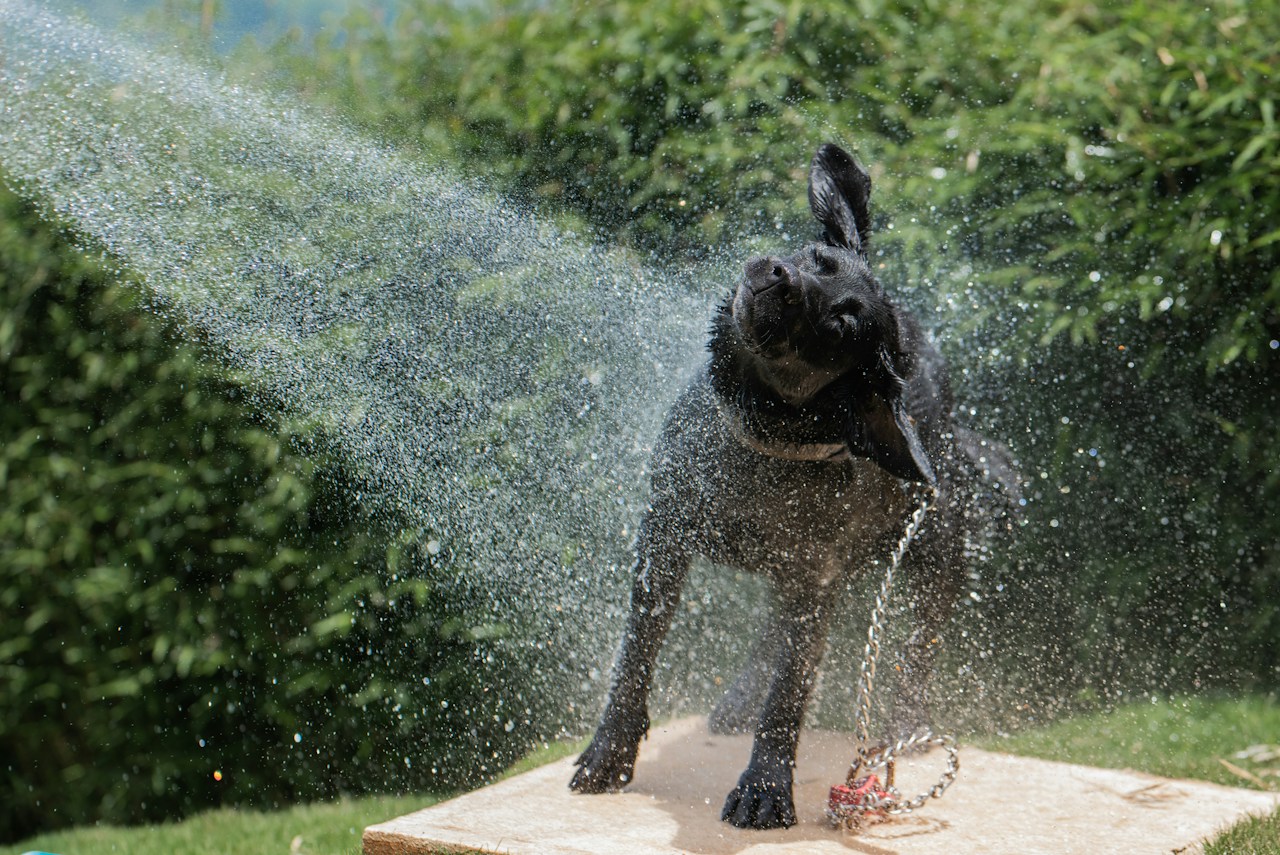One of the most common medical complaints we see in our office is dogs with skin infections, “hot spots” or allergic dermatitis, also known as atopic dermatitis (atopy), so if you want to know how to cure Dog Skin Allergies , you should keep reading this post.

Unlike people who react to allergens most commonly with nasal symptoms and / or hives, dogs react with skin and / or gastrointestinal problems. This is because there is a higher proportion of mast cells, which release histamines and other vasoactive substances in the face of an allergic challenge, in the skin of dogs.
These problems can range from poor coat texture or hair length, to itching and chewing, to hot spots and self-mutilation, gastrointestinal pain and discomfort, diarrhea and flatulence. Allergies can also play a role in chronic ear infections.
Intradermal skin tests can also be done. In this test method, a small amount of antigen is injected into a shaved part of the dog’s skin. This is done in a specific pattern and order, so that if the dog shows a small elevated reaction, the offending antigen can be identified.
After a period of time (hours), the shaved area is examined to detect which antigens, if any, created a reaction. Allergy tests are performed to develop a specific therapy for the allergic animal.
How to cure Dog Skin Allergies
Once you have identified the causes and the diagnosis, it is time to learn about the treatments that will allow you to know how to cure dermatitis in dogs, and they are:
1.- Medicated bathrooms
Many medicated shampoos have compounds that aim to soothe broken skin and calm inflammation. Also, frequent bathing (weekly to every two weeks) of the dog can remove allergens from the hair, which can contribute to skin allergy flare-ups.
Medicated baths are a great way to learn how to cure dermatitis in dogs, but the ones we recommend are those that actually contain antimicrobial and antifungal agents, as well as ingredients that allow the skin to bathe more frequently without drying it out.
Applying a post rinse also helps prevent skin and hair from drying out.
2.- Antihistamines
Antihistamines can be used safely in dogs. About a third of homeowners report success with antihistamines. These medications are excellent for understanding the most effective way to cure dermatitis in dogs, as they tend to have a variable effect between dogs. For some allergic dogs, antihistamines work very well to control the symptoms of allergic skin disease.
For other dogs, very little effect is seen. Therefore, a minimum of three different types of antihistamines should be tried before owners abandon this therapy.
Examples of antihistamines commonly used for dogs include Benadryl, Chlortrimeton, Atarax, Claritin, Zyrtec, and Clemastine. However, antihistamines are considered worth trying in most cases, as the side effects associated with antihistamines are low and they are generally inexpensive medications.
3.- Antibiotics and antifungal medications
Antibiotics are often needed to treat secondary skin infections. Antifungal medications are often needed, to treat secondary yeast infections, this is something necessary to learn how to cure dermatitis in dogs.
4.- Flea control
For dogs with this problem, a strict flea control regimen must be maintained. The best flea control options include using products like Advantage, Revolution, Frontline, Comfortis, and Sentinel.
5.- Supplements
Omega-3 and Omega-6 essential fatty acid supplements work to improve the overall health of the skin. These fatty acids are natural anti-inflammatory and antioxidant agents. They are reportedly helpful in 20% of allergic dogs. My own experience puts this figure a bit higher.
Without a doubt, they are worth a try to have more options when learning how to cure dermatitis in dogs, and because they are not harmful and have virtually no side effects. Omega-3 fatty acids are found in fish oils and omega-6 fatty acids are derived from plants that contain gamma-linolenic acid (GLA).
These supplements are different from those sold to produce a shiny coat. Products that contain omega-3 and omega-6 fatty acids include Alergen Caps and Halo.
6.- Hypoallergenic diets
Allergies develop through exposure, which is why most hypoallergenic diets incorporate protein and carbohydrates that your dog has never had before. As mentioned above, the quickest and best way to determine what foods your dog may or may not be allergic to is through allergy diagnostic tests.
Since dairy products, beef, and wheat are responsible for 80% of food allergies in dogs, these items should be avoided.
New sources of protein used in hypoallergenic diets include venison, egg, duck, kangaroo, and types of fish not commonly found in pet food. Carbohydrate sources include potatoes, peas, sweet potatoes, sweet potatoes, and canned pumpkin.
Hydrolyzed protein diets are diets in which the protein source has been synthetically reduced to small fragments.
The theory behind feeding a hydrolyzed protein source is that the proteins in the food should be small enough that the allergic dog’s immune system does not recognize the protein fragments and does not generate an immune response that results in an allergy.
Most pets with food allergies respond well to a store-bought hypoallergenic diet, but sometimes an animal suffers from allergies so extreme that the only option is a homemade diet. In this case, the diet must be personalized with the help of a veterinarian in order to know how to cure dermatitis in dogs.
7.- Corticosteroids and immunosuppressive agents
Cortisone products like prednisone, prednisolone, and dexamethasone reduce itching by reducing inflammation. These medications are not without side effects, so they should be used wisely in treating skin allergies.
Steroids should be considered only when allergy season is short, the amount of medication required is small, or to relieve a dog in extreme discomfort. Side effects can include increased thirst and appetite, increased need to urinate, and behavior changes.
Long-term use can result in diabetes and decreased resistance to infection. In some dogs, long-term low-dose alternative day therapy is the only management protocol that successfully controls the atopic pet.
This protocol should be used only as a last resort after all other methods have been exhausted to avoid potential long-term complications from the medication.
Cyclosporine (Atopica) is a drug that appears to be quite effective in reducing inflammation associated with skin allergies and in calming the immune system of the affected dog. However, the price of cyclosporine can be prohibitive for larger breed dogs, something to keep in mind when learning how to cure dermatitis in dogs.
8.- Immunotherapy (Hypo-sensitization)
Allergy shots are very safe and a great way to understand how to cure dermatitis in dogs, and many people have great success with them; However, they are very slow to work. It may take six to twelve months before improvement is seen.
Once the allergens for the dog are identified, an appropriate immunotherapy is made for that specific dog, and treatment can begin. Similarly, once the offending antigens are identified, a mixture of these antigens can be formulated in a hyposensitizing injection.
Depending on the type of agents used, these injections will be given over a period of weeks to months until the dog or cat develops immunity against the agents. After initial protection, an occasional booster may need to be given.
9.- Environmental control
If you know what substances your dog is allergic to, it will be easier to understand how to cure dermatitis in dogs and how to avoid using them. Even if you are desensitizing the dog with allergy shots, it is best to avoid the allergen entirely.
Molds can be reduced by using a dehumidifier or by placing activated charcoal on exposed soil on your house plants. Dusts and pollens are best controlled by using an air filter with a HEPA filter. Air conditioning can also reduce the circulating amounts of allergens in the air because windows are kept closed.
10. Medications for the thyroid
Healthy skin and a normal coat are the result of many factors, both external and internal. There are several glands in the body responsible for the production of hormones that are vital for the regulation of other bodily functions, as well as a normal skin surface and coat of hair.
Hypothyroidism can result in a poor layer of skin and hair, including hair loss or abnormal hair change, dull or brittle hair, altered pigmentation, and oily or dry skin.
A blood test is the simplest and most direct way to tell if your dog has hypothyroidism. The thyroid test may include all or part of the following:
- The T4 or Total T4 (TT4) baseline test – This is the most common test. Dogs with insufficient thyroid gland will have a reduced level of the T4 hormone.
However, there are other conditions that can cause T4 to drop, so if this test comes back positive for hypothyroidism, a vet should recommend an additional blood test, either the T3 test or the baseline TSH test.
- The baseline TSH test: measures the level of thyroid-stimulating hormone. In combination with the T4 or T3 test, it provides a more complete picture of the hormonal activity of your dog’s thyroid gland.
- T4 by RIA test (radioimmunoassay): The Free T4 test with RIA techniques does not appear to be more or less accurate than the previous TT4 test.
- Free T4 by ED (Equilibrium Dialysis): This test can provide more accurate data on the level of T4 hormone in your dog’s bloodstream.
- T3 baseline test: In combination with the T4 or TSH test, these two blood tests can provide a clearer picture of the hormone levels found in the bloodstream.
This test is not reliable when used alone. The T3 test should always be administered in combination with one of the other blood tests.
- TSH Response Test : In this test, the vet takes an initial measurement of the thyroid hormones in your dog’s bloodstream. And then injects thyroid-stimulating hormone (TSH) into the vein.
After 6 hours, a blood sample is drawn and the T4 level is checked. If your dog is hypothyroid, the T4 level will not rise even after injecting TSH. This is an expensive test and is used less frequently due to less production by manufacturers.
Hypothyroidism is treated with a daily dose of synthetic thyroid hormone called thyroxine (levothyroxine). Blood samples should be drawn periodically to assess the effectiveness of the dose and to make any necessary adjustments.
Successful management of the atopic and allergic dog is sometimes complicated and frustrating because multimodal management is necessary in most cases to control allergic outbreaks.
Proper diagnosis by a veterinarian and owner and follow-up care is essential to maximize the chances of curing or at least managing the severely affected allergy patient. So knowing how to cure dermatitis in dogs is more than necessary.

